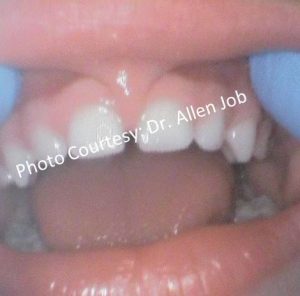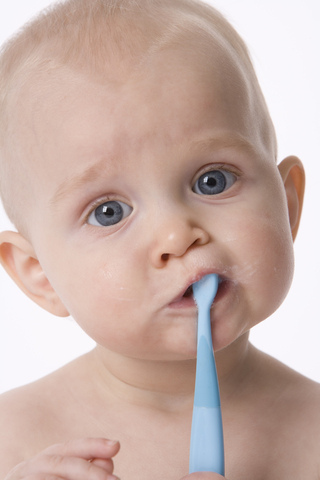Baby Steps: Why does my Baby Need to See the Dentist?
November 22nd, 2021
Here is an amazing fact: by the time your child reaches kindergarten class, more than 5 out of his or her 20 classmates will have dental cavities! Imagine that for a moment. Your child has just started the first phase of his or her educational journey and now more than a quarter of his or her classmates have a dental cavity. It's 28 percent to be exact, per the National Institute of Craniofacial Research.
Maybe you, as a parent, remember having dental cavities, as a child. And you might be thinking, "What's the big deal. Don't those teeth fall out anyway?" The answer comes later in this blog.
The CDC reports that dental cavities is the most prevalent chronic disease that our children are facing. This is more common that getting diagnosed with asthma or allergies!
What's the big deal. Don't those Baby Teeth Fall Out Anyway?
First, as a parent, I do not want to expose my child to any forms of disease, especially something that can be avoided by following a few simple steps at home.
Second, think about the time you had to have a filling at the dentist as a child. Though there are now modern advances to decrease pain and discomfort, there is still an experience that may not be all too pleasant.
Thirdly, a child who is in pain from a cavity will not be able to focus properly at school or at home. Sleep at home can also be disturbed, not only by your child, but in everyone at home.
Finally, there is cost associated with treating dental cavities. There is direct costs from the procedure. Also indirect costs need to be factored in such as, loss of income from taking your child to have a filling done, travel time, and time away from school.
There are physical and psychological factors that are associated with treating dental decay.
Instead of treating a problem after it has already occurred why not prevent the problem in the first place!
According to the American College of Obstetricians and Gynecologists, 89 percent of children age one year had an office based physician visit, while only 1.5 percent had a dental office visit.
Recommendations for Oral Health Care for your Infant.
Here are some recommendations that will give your child the best possible outcome of having optimal oral health care. Establish a dental home by age 1 for your child. This means having your child seen by the dentist by your child's 1st birthday. During the initial exam several areas will be discussed. This includes:
1. Oral exam of your child's mouth.
This will include an age appropriate demonstration of gum and teeth cleaning with fluoride treatment.
2. Assessment of your child's risk for dental decay.
This will include a road map to fend off any potential risks for getting cavities and recommendations for diet, flouride use, and the frequency for checkup appointments.
3. Cavities management.
If your child does have a cavity, then your dentist can give you ways to treat the cavity at an early stage. Most general dentists do not want to see infants, so make sure to seek out a pediatric dentist.
4. Injury prevention.
Learn how to decrease the risk to dental injury at home and also learn what to do if there is a dental injury, should that occur.
5. Teething.
Find out the signs and symptoms of teething and ways to treat it in easy steps at home.
6. Lip and tongue tie assessment.
If you child has had difficulty with breastfeeding or bottle feeding, then you would want to see your pediatric dentist as soon as you notice this issue. You can find more information about this here.
7. Non nutritive oral habits.
If your child loves to use her pacifier, sucks her finger, grinds her teeth, or has an abnormal tongue thrust, then all of these areas can be addressed by your pediatric dentist.
Instead of worrying about cavities, give your child the best chance of having a great start by seeing a dentist by age one! Your child will have many milestones in their future. Having a cavity shouldn't be one of them!
All Smiles Pediatric Dentistry
At All Smiles Pediatric Dentistry, we incorporate proven techniques to share with you and your child at each dental checkup visit. Dr. Allen Job and his team are committed to providing the latest in oral health care prevention. Check out our monthly blog posts! Our practice is centrally located in San Diego, CA.
COVID-19 Precautions
Find out how we are protecting our patients and our staff with our improved safety protocol.
Get to Know Us
Get acquainted with us by watching our practice video and find out what we do.
Scheduling an appointment for your child is easy! Start here to schedule an appointment. All of our forms are online. Fill them out securely from your smartphone or tablet and hit send. On appointment day, your child will be seen at their scheduled time. For example, if you have a 9:00 AM appointment, your child will be seen at 9:00 AM.
 Dr. Allen Job, DDS, MS, MPH, MS is a board certified pediatric dentist who practices in San Diego, California, where he specializes in prevention. For more than a decade, served as assistant professor for the Department of Pediatric Dentistry at Loma Linda University School of Dentistry (LLUSD). He is currently an instructor at LLUSD.
Dr. Allen Job, DDS, MS, MPH, MS is a board certified pediatric dentist who practices in San Diego, California, where he specializes in prevention. For more than a decade, served as assistant professor for the Department of Pediatric Dentistry at Loma Linda University School of Dentistry (LLUSD). He is currently an instructor at LLUSD.







